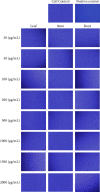In Vitro Cytotoxicity of Reproductive Stage Withania somnifera Leaf and Stem on HepG2 Cell Line
- PMID: 38169931
- PMCID: PMC10761218
- DOI: 10.1155/2023/8832166
In Vitro Cytotoxicity of Reproductive Stage Withania somnifera Leaf and Stem on HepG2 Cell Line
Abstract
Background: The ayurvedic plant Withania somnifera, a member of the Solanaceae family, has been used as a remedy for diverse health problems, including cancer.
Objectives: The objective of this investigation was to conduct a comparative analysis of the in vitro cytotoxic properties of methanolic extracts derived from the leaf, stem, and root of W. somnifera on HepG2 and L929 cell lines.
Methods: Methanolic extracts were obtained using the Soxhlet extraction method. To assess the in vitro anticancer action on the HepG2 and L929 cell lines, an MTT assay was performed. Changes in cell morphology were observed using an inverted microscope.
Results: The MTT assay results indicated that the leaf, stem, and root methanolic extracts of W. somnifera showed significantly higher in vitro cytotoxicity in HepG2 cells, with IC50 values of 43.06 ± 0.615, 45.60 ± 0.3, and 314.4 ± 0.795 μg/mL than in L929 cell lines with 78.77 ± 0.795, 90.55 ± 0.800, and 361.70 ± 0.795 μg/mL, respectively. The leaf methanolic extract was the most effective, followed by the stem methanolic extract in the HepG2 cell line.
Conclusion: The results of our study have confirmed that the methanolic extracts of both the leaf and stem of W. somnifera exhibit significant in vitro cytotoxicity in HepG2 cell lines, while displaying no significant cytotoxicity in the L929 cell line. Furthermore, the data obtained from the MTT assay indicate that the leaf methanolic extract possesses a more potent cytotoxic activity than the stem methanolic extract with respect to the HepG2 cell line. Further studies on the identification and isolation of bioactive metabolites are required to explore the mechanisms underlying their in vitro cytotoxicity.
Copyright © 2023 Lali Lingfa et al.
Conflict of interest statement
The authors declare that they have no conflicts of interest.
Figures





Similar articles
-
Evaluation and Comparison of the In Vitro Cytotoxic Activity of Withania somnifera Methanolic and Ethanolic Extracts against MDA-MB-231 and Vero Cell Lines.Sci Pharm. 2015 Sep 26;84(1):41-59. doi: 10.3797/scipharm.1507-13. Print 2016 Jan-Mar. Sci Pharm. 2015. PMID: 27110497 Free PMC article.
-
Evaluation of apoptotic activity of Withania coagulans methanolic extract against human breast cancer and Vero cell lines.J Ayurveda Integr Med. 2017 Jul-Sep;8(3):177-183. doi: 10.1016/j.jaim.2017.01.001. Epub 2017 Jul 6. J Ayurveda Integr Med. 2017. PMID: 28688542 Free PMC article.
-
Viwithan, a Standardized Withania somnifera Root Extract Induces Apoptosis in Murine Melanoma Cells.Pharmacogn Mag. 2018 Jan;13(Suppl 4):S801-S806. doi: 10.4103/pm.pm_121_17. Epub 2018 Jan 31. Pharmacogn Mag. 2018. PMID: 29491636 Free PMC article.
-
Review on anticancerous therapeutic potential of Withania somnifera (L.) Dunal.J Ethnopharmacol. 2021 Apr 24;270:113704. doi: 10.1016/j.jep.2020.113704. Epub 2020 Dec 25. J Ethnopharmacol. 2021. PMID: 33359918 Review.
-
Metabolomics of Withania somnifera (L.) Dunal: Advances and applications.J Ethnopharmacol. 2021 Mar 1;267:113469. doi: 10.1016/j.jep.2020.113469. Epub 2020 Oct 16. J Ethnopharmacol. 2021. PMID: 33075439 Review.
Cited by
-
Nature-Inspired Strategies in Cancer Management: The Potential of Plant Extracts in Modulating Tumour Biology.Int J Mol Sci. 2025 Jul 18;26(14):6894. doi: 10.3390/ijms26146894. Int J Mol Sci. 2025. PMID: 40725141 Free PMC article. Review.
References
LinkOut - more resources
Full Text Sources

